Posts
'Big Hairy Audacious Goals' and the Importance of Being Professionally Engaged
If you have not read Good to Great, by Jim Collins, I would recommend…

The Life Wheel - Professional and Personal Areas of Focus
The Life Wheel is a tool used in coaching to help you evaluate…

Zoom-ify Your Space
What does your desk and work area say about you?
What does…

Business Strategies = Business Sustainability + Growth
Are your business strategies driving your business sustainability…

Having the Right People in The Right Job Fosters Success
Success
Having an individual in a position that they are not…

